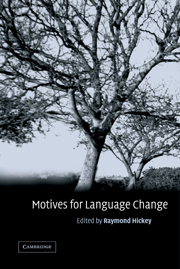Book contents
- Frontmatter
- Contents
- Notes on the contributors
- Acknowledgements
- Introduction
- Part I The phenomenon of language change
- Part II Linguistic models and language change
- Part III Grammaticalisation
- Part IV The social context for language change
- Part V Contact-based explanations
- 10 The quest for the most ‘parsimonious’ explanations: endogeny vs. contact revisited
- 11 Diagnosing prehistoric language contact
- 12 The ingenerate motivation of sound change
- 13 How do dialects get the features they have? On the process of new dialect formation
- Part VI The typological perspective
- Index
- References
10 - The quest for the most ‘parsimonious’ explanations: endogeny vs. contact revisited
Published online by Cambridge University Press: 22 September 2009
- Frontmatter
- Contents
- Notes on the contributors
- Acknowledgements
- Introduction
- Part I The phenomenon of language change
- Part II Linguistic models and language change
- Part III Grammaticalisation
- Part IV The social context for language change
- Part V Contact-based explanations
- 10 The quest for the most ‘parsimonious’ explanations: endogeny vs. contact revisited
- 11 Diagnosing prehistoric language contact
- 12 The ingenerate motivation of sound change
- 13 How do dialects get the features they have? On the process of new dialect formation
- Part VI The typological perspective
- Index
- References
Summary
Introduction
In his book Historical linguistics and language change (see Lass 1997) and in a number of influential papers (see, e.g., Lass and Wright 1986; Lass 1990a, b), Roger Lass has put forward the argument that, whenever there is a possibility of dual or multiple origin for a given feature, endogeny is always to be preferred to language contact because it provides the most ‘parsimonious’ explanations for linguistic innovations. According to Lass, this methodological principle can also be applied to the various ‘Extraterritorial Englishes’ (ETEs) such as American English, South African English, or Hiberno-English: most of their distinctive characteristics are best explained as perfectly normal internal developments rather than as results of influence from languages other than English.
In this chapter I will discuss some lexical and structural evidence from some varieties of English spoken in, or near, the (formerly) Celtic-speaking areas of the British Isles which shows that, although Lass's methodological principle is a useful tool, it does not suffice to account for some of the problematic linguistic phenomena found in these varieties. More specifically, I will argue that the case for contact influence remains strong even with respect to some features which have formal parallels both in earlier English and in the various Celtic ‘substratum’ languages.
- Type
- Chapter
- Information
- Motives for Language Change , pp. 161 - 173Publisher: Cambridge University PressPrint publication year: 2003
References
- 6
- Cited by



